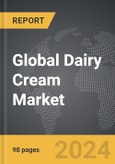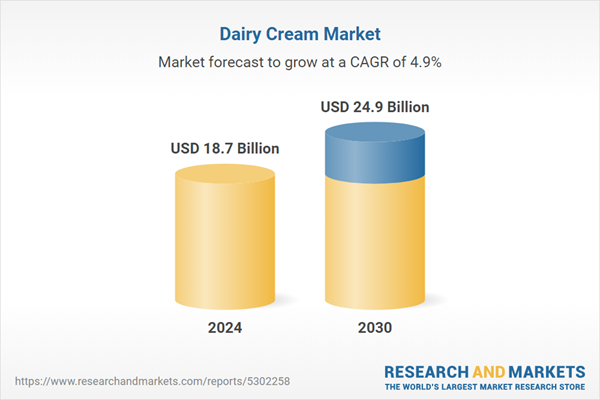The global market for Dairy Cream was valued at USD 18.7 Billion in 2024 and is projected to reach USD 24.9 Billion by 2030, growing at a CAGR of 4.9% from 2024 to 2030. This comprehensive report provides an in-depth analysis of market trends, drivers, and forecasts, helping you make informed business decisions.
Global Dairy Cream Market - Key Trends and Drivers Summarized
Why Is Dairy Cream a Staple in Kitchens and Food Production?
Dairy cream is a rich, high-fat dairy product separated from whole milk, known for its luxurious texture, creamy taste, and versatility in both culinary and industrial food applications. The cream naturally rises to the top of milk due to its lower density and higher fat content, traditionally collected through gravity separation or, more commonly today, by mechanical centrifugation. The fat content of dairy cream can range from 18% to over 48%, depending on the type of cream being produced, such as light cream, whipping cream, or heavy cream. The production process involves pasteurization to ensure safety and extend shelf life, followed by homogenization to evenly distribute the fat globules and prevent the cream from separating. Some varieties, such as double cream or clotted cream, undergo additional processing to achieve a thicker consistency and richer flavor. The end product can be used in a variety of forms, from liquid cream to aerosol cans or spreadable versions. Dairy cream's composition of fat, protein, and water makes it a valuable ingredient in both home cooking and commercial food production, providing a smooth mouthfeel, enhancing flavors, and acting as a stabilizer in emulsions. Its ability to whip into a stable foam when aerated makes it indispensable in desserts and baked goods, while its high-fat content lends a luscious texture to sauces, soups, and gourmet dishes.Why Is Dairy Cream So Invaluable Across Culinary and Food Production Sectors?
Dairy cream's widespread use is a testament to its unmatched ability to enhance flavor, texture, and visual appeal in a wide range of culinary and food production applications. In the culinary world, cream is prized for its versatility and ability to elevate both sweet and savory dishes. Its high-fat content provides a silky texture and rich mouthfeel, making it a key ingredient in creamy soups, sauces, and dressings. In desserts, dairy cream is the foundation for products like whipped cream, ganache, custards, and ice cream, where its emulsifying properties and ability to trap air contribute to light, airy textures. Additionally, its mild, slightly sweet flavor enhances the natural tastes of other ingredients without overpowering them, making it a preferred choice in recipes that require subtle flavor balancing. Beyond its culinary uses, dairy cream plays a significant role in the food manufacturing sector. Its functional properties - such as its ability to act as a stabilizer, thickener, and emulsifier - make it a critical component in processed foods like cream cheese, butter, confectionery items, and ready-to-eat meals. Industrially, cream is often used in reconstituted or dehydrated forms, such as cream powder, to improve shelf stability and reduce transportation costs. The demand for cream is also driven by its versatility in value-added products like flavored creams, cream-based sauces, and cream liqueurs. Furthermore, the growing trend toward premium and indulgent foods has led manufacturers to incorporate higher-fat creams in gourmet product lines, capitalizing on consumers' willingness to pay more for richer, high-quality ingredients.What Innovations Are Transforming the Dairy Cream Industry?
The dairy cream industry is experiencing a wave of innovations aimed at improving product quality, extending shelf life, and catering to changing consumer preferences for healthier and more sustainable options. One of the major areas of innovation is in cream processing technologies. Ultra-high temperature (UHT) pasteurization and aseptic packaging techniques are now commonly used to extend the shelf life of cream without the need for preservatives, making it more convenient for both consumers and food manufacturers. In addition, advancements in homogenization methods have led to the development of cream products with enhanced stability and resistance to separation, enabling their use in complex food formulations that require consistent texture and performance. Another significant trend is the rise of hybrid dairy products that blend cream with plant-based ingredients, such as coconut or almond cream, to create lower-fat, lactose-free, or vegan-friendly alternatives that mimic the texture and flavor of traditional cream. These innovations are addressing the growing consumer demand for plant-based foods while maintaining the functionality and appeal of conventional dairy cream. Furthermore, the incorporation of probiotics and other functional ingredients into cream products is gaining popularity, particularly in markets focused on health and wellness. Probiotic-rich creams and reduced-fat formulations that still deliver a rich mouthfeel are emerging as key product categories in response to increasing health consciousness. On the sustainability front, innovations in dairy farming practices, such as improved animal feed and carbon-neutral production techniques, are helping producers lower the environmental footprint of cream production, appealing to eco-conscious consumers. Additionally, smart packaging solutions with features like temperature indicators and resealable designs are being introduced to enhance freshness and reduce food waste.What Factors Are Fueling the Growth of the Dairy Cream Market?
The growth in the dairy cream market is driven by several factors, including rising demand for premium dairy products, increased application in convenience foods, and the growing trend towards clean-label ingredients. One of the primary drivers is the resurgence of interest in high-quality, natural dairy products, as consumers increasingly seek indulgent, wholesome foods with authentic flavors. This shift is particularly evident in the premium food and beverage segments, where cream is being incorporated into gourmet sauces, artisanal desserts, and high-end ready-to-eat meals. The demand for full-fat dairy products has also been bolstered by changing perceptions about dietary fats. Many consumers are moving away from low-fat diets and embracing the health benefits of natural fats, which has spurred interest in cream-based products that offer a richer, more satisfying taste experience. Another factor contributing to market growth is the expanding use of dairy cream in the convenience food sector. Cream is a key ingredient in the formulation of soups, sauces, and meal kits, where its ability to enhance mouthfeel and improve flavor profiles is highly valued. The rising popularity of cream-based coffee drinks, both in cafes and at home, is also driving demand, as consumers look for indulgent, café-quality experiences in their own kitchens. Furthermore, the increasing adoption of clean-label and minimally processed foods is influencing product development strategies, with manufacturers opting for cream as a natural alternative to synthetic thickeners and stabilizers. This aligns with consumer preferences for short ingredient lists and products that are free from additives. Technological advancements in cream production and packaging are further supporting market growth by extending shelf life and reducing costs, making cream more accessible to a wider range of consumers. Lastly, the globalization of food culture and the rise of Western culinary trends in emerging markets are contributing to increased demand for cream-based products in regions like Asia-Pacific and Latin America, where dairy consumption is on the rise. These factors are collectively driving the growth and diversification of the dairy cream market, positioning it as a dynamic and evolving segment of the global dairy industry.Report Scope
The report analyzes the Dairy Cream market, presented in terms of market value (USD Thousand). The analysis covers the key segments and geographic regions outlined below.Segments
Type (Thickened Cream & Whipping Cream, Fresh Cream, Sour Cream, Other Types); End-Use (Food Processing, Food Service, Food Retail).Geographic Regions/Countries
World; United States; Canada; Japan; China; Europe (France; Germany; Italy; United Kingdom; Spain; Russia; and Rest of Europe); Asia-Pacific (Australia; India; South Korea; and Rest of Asia-Pacific); Latin America (Argentina; Brazil; Mexico; and Rest of Latin America); Middle East (Iran; Israel; Saudi Arabia; United Arab Emirates; and Rest of Middle East); and Africa.Key Insights:
- Market Growth: Understand the significant growth trajectory of the Thickened Cream & Whipping Cream segment, which is expected to reach $10.2 Billion by 2030 with a CAGR of a 5.5%. The Fresh Cream segment is also set to grow at 4.8% CAGR over the analysis period.
- Regional Analysis: Gain insights into the U.S. market, valued at $4.9 Billion in 2024, and China, forecasted to grow at an impressive 7.3% CAGR to reach $5.4 Billion by 2030. Discover growth trends in other key regions, including Japan, Canada, Germany, and the Asia-Pacific.
Report Features:
- Comprehensive Market Data: Independent analysis of annual sales and market forecasts in USD from 2024 to 2030.
- In-Depth Regional Analysis: Detailed insights into key markets, including the U.S., China, Japan, Canada, Europe, Asia-Pacific, Latin America, Middle East, and Africa.
- Company Profiles: Coverage of major players such as Arla Foods, Agropur, Dean Foods, Fonterra Co-operative Group, Graham's Family Dairy and more.
- Complimentary Updates: Receive free report updates for one year to keep you informed of the latest market developments.
Why You Should Buy This Report:
- Detailed Market Analysis: Access a thorough analysis of the Global Dairy Cream Market, covering all major geographic regions and market segments.
- Competitive Insights: Get an overview of the competitive landscape, including the market presence of major players across different geographies.
- Future Trends and Drivers: Understand the key trends and drivers shaping the future of the Global Dairy Cream Market.
- Actionable Insights: Benefit from actionable insights that can help you identify new revenue opportunities and make strategic business decisions.
Key Questions Answered:
- How is the Global Dairy Cream Market expected to evolve by 2030?
- What are the main drivers and restraints affecting the market?
- Which market segments will grow the most over the forecast period?
- How will market shares for different regions and segments change by 2030?
- Who are the leading players in the market, and what are their prospects?
Some of the 52 major companies featured in this Dairy Cream market report include:
- Arla Foods
- Agropur
- Dean Foods
- Fonterra Co-operative Group
- Graham's Family Dairy
- Gujarat Co-operative Milk Marketing Federation Ltd. (Amul)
- Lactalis Group
- Land O’Lakes, Inc.
- Nestlé S.A.
- Royal FrieslandCampina N.V.
Table of Contents
I. METHODOLOGYII. EXECUTIVE SUMMARY2. FOCUS ON SELECT PLAYERSIII. MARKET ANALYSISSOUTH KOREAREST OF ASIA-PACIFICARGENTINABRAZILMEXICOREST OF LATIN AMERICAIRANISRAELSAUDI ARABIAUNITED ARAB EMIRATESREST OF MIDDLE EASTIV. COMPETITION
1. MARKET OVERVIEW
3. MARKET TRENDS & DRIVERS
4. GLOBAL MARKET PERSPECTIVE
UNITED STATES
CANADA
JAPAN
CHINA
EUROPE
FRANCE
GERMANY
ITALY
UNITED KINGDOM
SPAIN
RUSSIA
REST OF EUROPE
ASIA-PACIFIC
AUSTRALIA
INDIA
LATIN AMERICA
MIDDLE EAST
AFRICA
Companies Mentioned (Partial List)
A selection of companies mentioned in this report includes, but is not limited to:
- Arla Foods
- Agropur
- Dean Foods
- Fonterra Co-operative Group
- Graham's Family Dairy
- Gujarat Co-operative Milk Marketing Federation Ltd. (Amul)
- Lactalis Group
- Land O’Lakes, Inc.
- Nestlé S.A.
- Royal FrieslandCampina N.V.
Table Information
| Report Attribute | Details |
|---|---|
| No. of Pages | 98 |
| Published | April 2025 |
| Forecast Period | 2024 - 2030 |
| Estimated Market Value ( USD | $ 18.7 Billion |
| Forecasted Market Value ( USD | $ 24.9 Billion |
| Compound Annual Growth Rate | 4.9% |
| Regions Covered | Global |









